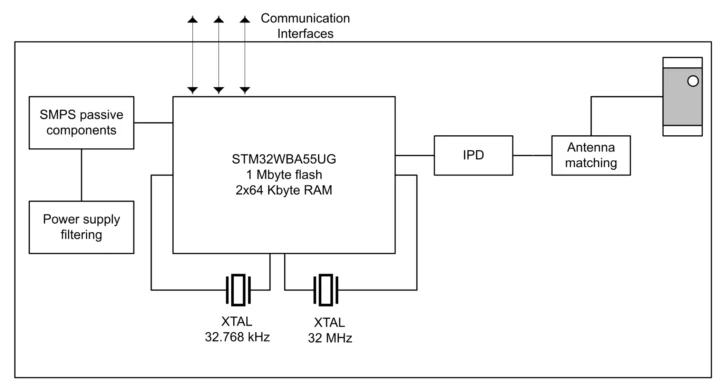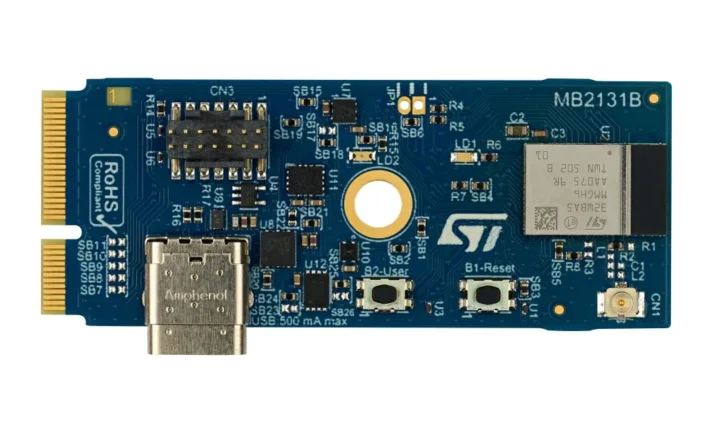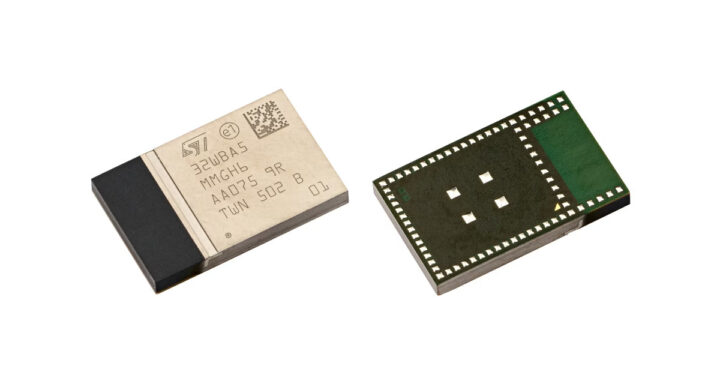STMicro’s STM32WBA5MMG is a tiny (12.5 x 8 mm), ultra-low-power 2.4 GHz wireless module based on the STM32WBA55UG wireless microcontroller with support for Bluetooth 6.0 LE, Zigbee 3.0, and OpenThread.
The company further adds that designing a board for the module does not require any RF expertise, it provides a fully integrated Bill of Materials (BOM) with 32 MHz and 32 kHz crystals and integrated antenna matching or optional external antenna configurations, and its compatibility with 2-layer PCBs helps reduce costs.
STM32WBA5MMG specifications:
- Wireless MCU – STMicro STM32WBA55UG
- Core – 32-bit Arm Cortex-M33 CPU with TrustZone®, MPU, DSP, and FPU
- Memory – 128 KB SRAM, including 64 KB with parity check
- Storage
- 1 MB flash memory with ECC, including 256 KB with 100 kcycles
- 512-byte (32 rows) OTP
- ART Accelerator – 8 KB instruction cache allowing 0-wait-state execution from flash memory (frequency up to 100 MHz, 150 DMIPS)
- Wireless
- Bluetooth LE 6.0
- Up to 2 Mbps data rate
- Support for LE audio
- Support for direction finding
- LE power control, Isochronous channels, Extended advertising, Periodic advertising, LE secure connections
- 802.15.4 radio for Thread, Matter for Border router, and Zigbee 3.0
- Tx Power – Up to +10 dBm with 1 dB steps
- Rx sensitivity – -96 dBm (Bluetooth LE at 1 Mbit/s), -97.5 dBm (IEEE 802.15.4 at 250 Kbit/s)
- Bluetooth LE 6.0
- Antenna – Integrated antenna with IPD (integrated passive device); optional external antenna configuration
- Peripherals – Up to 33 I/Os (most of them 5 V-tolerant) with interrupt capability, 2x SPI, 2x I2C, UART, ADC, etc… (same as STM32WBA55 MCU)
- Security and cryptography
- Secure firmware installation (SFI)
- Advanced encryption standards (AES) accelerators
- Public key accelerator (PKA)
- Protection against differential power analysis (DPA)
- HASH hardware accelerator
- True random number generator (RNG)
- 96-bit UID
- CRC calculation unit
- Flash readout and hide protection (RDP and HDP)
- Tamper detection
- Root hardware unique key (RHUK)
- Serial wire debug (SWD) and JTAG
- Misc – 32 MHz and 32 kHz crystals
- Supply Voltage – 1.71 to 3.6V
- Low power
- SMPS and ultra-low-power modes for battery longevity
- Consumption (identical to STAM32WBA55)
- < 140 nA standby mode
- 0.9 μA in ULP-mode with full RAM
- Down to 1.35μA with RTC and 64KB of RAM.
- 30 µA/MHz when running at 100 MHz
- 5.2 mA BLE Radio Tx current
- Package – SiP-LGA76 (12.5 x 8 mm)
- Temperature Range – -40°C to 85°C
- Certifications
- Done – CE, FCC, ISED, MIC, RoHS, REACH
- Planned – KC, NCC, SRRC, ANATEL
- ECOPACK2 compliant

The module is supported by the STM32CubeWBA MCU Package with a completely royalty-free protocol stack, software libraries, and examples usable wit hthe STM32CubeIDE or third-party IDEs like IAR Embedded Workbench or MDK-ARM.
The easiest way to get started is through the B-WBA5M-WPAN connectivity expansion board with the following specifications:
- Wireless module – STM32WBA5MMG as described above
- Storage – 256Kbit serial I2C bus EEPROM
- MEMS sensors
- High-accuracy temperature sensor
- 3D accelerometer and 3D gyroscope
- Host interface – M.2 E-Key connector with UART, SPI, I2C, and SAI interfaces, as well as power signals
- Debugging – STDC14 debug connector (CN3) for external STLINK-V3SET debugger
- Misc
- User LED
- User and reset push buttons
- Power Supply – USB Type-C or via M.2 EKey connector

The STM32WBA5MMG is designed for home automation, wellness, healthcare, and personal trackers, gaming and toys, beacons and accessories, and industrial applications like the STM32WBA5x series, but the design should be easier since the module is already certified and it is compatible with 2-layer PCBs.
The STM32WBA5MMG module sells for $5.4 per unit for 10k orders, and the B-WBA5M-WPAN connectivity expansion board is offered for $37.51 in single units. More details can be found on the product pages for the wireless module and expansion board.

Jean-Luc started CNX Software in 2010 as a part-time endeavor, before quitting his job as a software engineering manager, and starting to write daily news, and reviews full time later in 2011.
Support CNX Software! Donate via cryptocurrencies, become a Patron on Patreon, or purchase goods on Amazon or Aliexpress. We also use affiliate links in articles to earn commissions if you make a purchase after clicking on those links.





Would be nice if some cheap boards with this would appear,could be a nice alternative to esp32